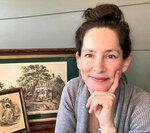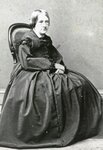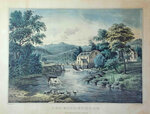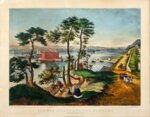 Narrowsburg
NarrowsburgLight Rain Fog/Mist, 43°
Wind: 8.1 mph
 Narrowsburg
NarrowsburgNARROWSBURG, NY — Learning about Fanny Palmer isn’t easy. It’s “the challenge of telling the story of someone who didn’t become famous,” said Tina Spangler, a …
Stay informed about your community and support local independent journalism.
Subscribe to The River Reporter today. click here
This item is available in full to subscribers.
Please log in to continue |




NARROWSBURG, NY — Learning about Fanny Palmer isn’t easy. It’s “the challenge of telling the story of someone who didn’t become famous,” said Tina Spangler, a Narrowsburg-based filmmaker.
Palmer was known mainly for her work for Currier and Ives.
You’ve seen those prints. Hazy like a dream, a portrayal of America in some magical Victorian era, all beautiful landscapes and horses, men in tall hats and women in enormous skirts.
Many of those images—especially the landscapes—were created by Palmer.
She lived in Brooklyn, but her works reached across time and place to Narrowsburg in 2020 and to Spangler.
“She is the OG commercial artist,” Spangler said. “She worked for Currier and Ives, and created a little over 200 lithographs.”
Fanny Palmer (1812-1876) grew up in England and moved to the United States in the 1840s. Her husband wasn’t able to support the family, so she had to take that role.
“Her goal was to use her passion and her training to support her family,” Spangler said.
An artist, Palmer had trained in lithography, a printmaking process that involved inking an image treated with grease
She was hired by Nathaniel Currier and created lithographs of landscapes and rural life for his printing company.
Currier and Ives (Ives, the bookkeeper for Currier’s business, became a partner in 1857) was known for those lithographs—cheap and pretty-enough works that “everyday Americans could hang on their walls,” Spangler said. “And Fanny did some of their most enduring prints. Her work is so iconic.”
A Currier and Ives lithograph was beloved because it was “an idealized vision of America,” she said, popular at a stressful time in the country’s history.
The mid-19th century saw the abolition movement and the Civil War, the rise of industrialization and the corresponding rise of immigration, fabulous wealth and deep poverty.
“The public was drawn to these scenes that reassured them that all was well,” Spangler said.
Intriguing as the lithographs were, Fanny’s personal story was even more compelling. Here was a 19th-century woman who had to support her family. “She had to step into that role and make sure money was coming in.”
And Brooklyn, where Palmer lived, was interesting too. “It was just before everything changed,” Spangler said of Palmer’s time there. “Brooklyn was a collection of villages and farms. Farmers grew crops. The scenes she drew”—those bucolic images of horses and greenery and a slower pace—“those were from life.”
In fact, Palmer’s work documented that point in time for much of the rest of the city. “She drew New York skylines, activity on rivers, bustling waterways. [You can see] downtown Staten Island. It’s a great record, and a representation of life as she experienced it.”
“It seems unjust that her story hasn’t been told,” Spangler said.
Fascinated by Palmer’s work and era, Spangler started thinking about turning it all into a documentary.
Producing a film isn’t easy. Research needs to be done, people recruited, locations found for shooting and rented if necessary. Money needs to be raised.
Spangler, the founder of the Big Eddy Film Festival and a filmmaker (most recently she has been producing pieces for “Sesame Street”), knew what to do.
To date, she’s shot footage and done interviews for a two-minute teaser and received a Hearst Fellowship to conduct research. Grants and foundational support are being sought.
But crowdfunding is key too. That’s the way indie films get funded now, Spangler said—small donations that add up to a movie. A fundraiser has been set up at seedandspark.com; she hopes to raise $25,000.
Crowdfunding “is also a great way for individuals to be involved with the film and get insider and behind-the-scenes glimpses into the filmmaking process,” she added. Each donation level offers incentives or rewards.
“Seed & Spark is a trusted site that is exclusively for raising funds for film projects,” Spangler said. “Making a credit card contribution is very easy on the website, and if for any reason we do not make our goal, supporters’ credit cards will not be charged.
The fundraiser will be up through January.
The project feels right, and the time feels right to bring Fanny Palmer’s life to film, Spangler said.
Even if it takes a crowd to fund it.
“Documentaries aren’t Hollywood,” she said. “It’s not blockbuster storytelling.”
It’s about the extraordinary, found in ordinary lives.
Documentaries are enduring. And available to all.
“Like lithography,” Spangler said.
To donate to the project, visit www.seedandspark.com/fund/fanny-palmer#story.
Comments
No comments on this item Please log in to comment by clicking here